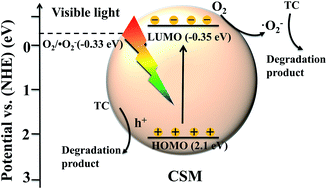Facile synthesis of chitosan membranes for visible-light-driven photocatalytic degradation of tetracycline hydrochloride†
Abstract
Due to the film-forming ability of polymers, a variety of photocatalytic membranes (PMs) based on polymers easily being separated and reused have been constructed for wastewater contaminant treatment. During their construction processes, chitosan (CS) as a bio-polymer with its distinct merits of abundant resources, low-cost and environmental-friendliness, as well as formability and ease of modification, has attracted great attention. However, the role of CS was mostly believed to be just a support or an adsorbent for fixing or dispersing photocatalysts. Whether CS possessed photocatalytic activity or not still remained vague. Herein, in this work, CS membranes (CSM) were facilely prepared for photocatalytic degradation of tetracycline hydrochloride (TC, a model organic pollutant) in aqueous solution, and its photocatalytic performance was investigated and compared with that of CSP (CS powder) and TiO2-P25 (a commercially used photocatalyst). The results showed that the single-phased CSM exhibited a better visible light photocatalytic activity. After visible light irradiation for 60 minutes, the degradation efficiency of TC can reach above 90% when the CSM was used as a photocatalyst, while with the same irradiation time interval, less TC could be degraded over both CSP and TiO2-P25. Through radical scavenging and EPR experiments, ˙O2− and h+ were found to be the main active oxygen species generated in the reaction system for TC degradation. After being washed with 2 wt% NaOH solution, the CSM revealed a good recyclability implying its potential for practical applications. This study would provide a certain theoretical and data basis for the future development of CS-based PMs and photocatalysts.



 Please wait while we load your content...
Please wait while we load your content...